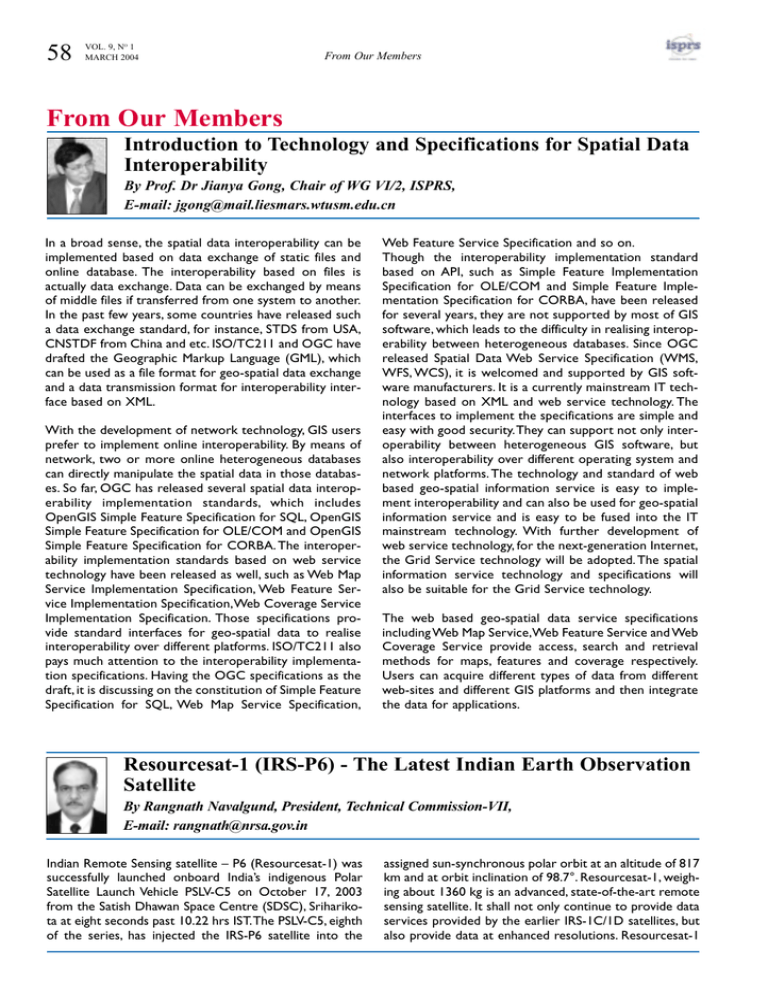58
advertisement

58 VOL. 9, NO 1 MARCH 2004 From Our Members From Our Members Introduction to Technology and Specifications for Spatial Data Interoperability By Prof. Dr Jianya Gong, Chair of WG VI/2, ISPRS, E-mail: jgong@mail.liesmars.wtusm.edu.cn In a broad sense, the spatial data interoperability can be implemented based on data exchange of static files and online database. The interoperability based on files is actually data exchange. Data can be exchanged by means of middle files if transferred from one system to another. In the past few years, some countries have released such a data exchange standard, for instance, STDS from USA, CNSTDF from China and etc. ISO/TC211 and OGC have drafted the Geographic Markup Language (GML), which can be used as a file format for geo-spatial data exchange and a data transmission format for interoperability interface based on XML. With the development of network technology, GIS users prefer to implement online interoperability. By means of network, two or more online heterogeneous databases can directly manipulate the spatial data in those databases. So far, OGC has released several spatial data interoperability implementation standards, which includes OpenGIS Simple Feature Specification for SQL, OpenGIS Simple Feature Specification for OLE/COM and OpenGIS Simple Feature Specification for CORBA. The interoperability implementation standards based on web service technology have been released as well, such as Web Map Service Implementation Specification, Web Feature Service Implementation Specification,Web Coverage Service Implementation Specification. Those specifications provide standard interfaces for geo-spatial data to realise interoperability over different platforms. ISO/TC211 also pays much attention to the interoperability implementation specifications. Having the OGC specifications as the draft, it is discussing on the constitution of Simple Feature Specification for SQL, Web Map Service Specification, Web Feature Service Specification and so on. Though the interoperability implementation standard based on API, such as Simple Feature Implementation Specification for OLE/COM and Simple Feature Implementation Specification for CORBA, have been released for several years, they are not supported by most of GIS software, which leads to the difficulty in realising interoperability between heterogeneous databases. Since OGC released Spatial Data Web Service Specification (WMS, WFS, WCS), it is welcomed and supported by GIS software manufacturers. It is a currently mainstream IT technology based on XML and web service technology. The interfaces to implement the specifications are simple and easy with good security.They can support not only interoperability between heterogeneous GIS software, but also interoperability over different operating system and network platforms. The technology and standard of web based geo-spatial information service is easy to implement interoperability and can also be used for geo-spatial information service and is easy to be fused into the IT mainstream technology. With further development of web service technology, for the next-generation Internet, the Grid Service technology will be adopted. The spatial information service technology and specifications will also be suitable for the Grid Service technology. The web based geo-spatial data service specifications including Web Map Service,Web Feature Service and Web Coverage Service provide access, search and retrieval methods for maps, features and coverage respectively. Users can acquire different types of data from different web-sites and different GIS platforms and then integrate the data for applications. Resourcesat-1 (IRS-P6) - The Latest Indian Earth Observation Satellite By Rangnath Navalgund, President, Technical Commission-VII, E-mail: rangnath@nrsa.gov.in Indian Remote Sensing satellite – P6 (Resourcesat-1) was successfully launched onboard India’s indigenous Polar Satellite Launch Vehicle PSLV-C5 on October 17, 2003 from the Satish Dhawan Space Centre (SDSC), Sriharikota at eight seconds past 10.22 hrs IST.The PSLV-C5, eighth of the series, has injected the IRS-P6 satellite into the assigned sun-synchronous polar orbit at an altitude of 817 km and at orbit inclination of 98.7°. Resourcesat-1, weighing about 1360 kg is an advanced, state-of-the-art remote sensing satellite. It shall not only continue to provide data services provided by the earlier IRS-1C/1D satellites, but also provide data at enhanced resolutions. Resourcesat-1 VOL. 9, NO 1 MARCH 2004 From Our Members AWiFS image covering Manas Sarovar Lake. LISS-III image covering parts of LISS-III image covering Mildura LISS-IV MX image covering part Myanmar. region, Australia. of Kuwait city. carries: - A high resolution Linear Imaging Self Scanner (LISS-IV) operating in three spectral bands in the Visible and Near Infrared Region (VNIR) with 5.8 m spatial resolution and steerabIe up to ± 26° across track to obtain stereoscopic imagery and achieve five day revisit capability - A medium resolution LISS-III camera operating in three spectral bands in VNIR and one in Short Wave Infrared (SWIR) band with 23.5 m spatial resolution - An Advanced Wide Field Sensor (AWiFS) operating in three spectral bands in VNIR and one band in SWIR with 56 m nominal spatial resolution. Resourcesat-1 is a global mission. Many ground stations set up across the globe would be receiving data. Resourcesat-1 also carries a solid state recorder - with a capacity of 120 Giga Bits to store on-board, the images taken by its cameras which can be read out later to the ground stations. National Remote Sensing Agency (NRSA) commenced data reception of Resourcesat-1 through its earth station at Shadnagar near Hyderabad, India from October 25, 2003, when the three cameras were switched on. Detailed specifications of the sensors are given in the enclosed table. PAYLOAD Spatial Resolution (m) Swath (km) Spectral bands (µm) LISS-IV 5.8 23.9 (MX Mode) 70.3 (PAN Mode) 0.52-0.59 0.62-0.68 0.77-0.86 Quantisation (bits) Square Wave response (at Nyquist) 7 >0.20 Power (W) Weight (kg) Data Rate (MBPS) 216 169.5 105 Sensors details. 59 Potential Utility Unique to Resourcesat-1 is its ability to acquire data at multiple spatial resolutions simultaneously from the same platform addressing the information needs at macro, meso and micro-scales. Data from various sensors on board IRS-P6 are expected to further enhance the discriminability of land use / land cover classes, multiple crops and crop condition assessment and improved snow cover estimation. AWiFS camera offering data at 56m resolution, in four spectral bands including short-wave infrared, covering full albedo in its dynamic range at 10 bit radiometry would open a new vista of applications. In addition, simultaneous availability of remote sensing data in the same spectral channels at different spatial resolutions and swath coverage enables extension of LISS-IV / III based information to the AWiFS coverage by spectral unmixing and data merging techniques, thus enabling regional level crop monitoring and condition assessment. The SWIR band data (1.55 to 1.70 mm) shall aid in better discrimination of moist black soils and water bodies through digital classifiers. High resolution multispectral data at 6 m would be useful in collection of more detailed spectral observations related to the crop canopy, crop condition, land use dynamics, biodiversity, soil phase information, geological LISS-III 23 AWiFS 56 141 0.52-0.59 0.62-0.68 0.77-0.86 1.55-1.70 7 B2>0.40 B3>0.40 B4>0.35 B5>0.20 70 106.1 52.5 740 0.52-0.59 0.62-0.68 0.77-0.86 1.55-1.70 10 B2>0.40 B3>0.40 B4>0.35 B5>0.20 114 103.6 52.5 60 VOL. 9, NO 1 MARCH 2004 From Our Members information etc. LISS-IV camera provides 70 km swath data in a single band or multispectral data at 23 km swath. LISS-IV camera onboard IRS-P6 has capability of off nadir viewing. Thus, it is also possible to acquire LISS-IV stereo data with base-to-height (B/H) ratio suitable for topo- graphic mapping like DEM generation and ortho-image generation. Initial phase operations are over and the evaluation of data quality has indicated that all three sensors are working as per the specifications. Excellent images have been obtained. Set of sample images are shown here. Advertising Policy* for ISPRS Highlights 1/1page, FC US$ 1,235 1/1 page, BW US$ 910 1/2 page, FC US$ 740 1/2 page, BW US$ 545 Inside cover US$ 1,870 Backcover US$ 2,335 All prices are nett prices per insertion.Sustaining Members receive 10% discount. Ordinary, Associate and Regional Members may receive complimentary advertising space with the approval of the Secretary General. Scientific Societies may be entitled to 50% discount with the approval of the Secretary General. 1. • • • The following discount rates are applicable: Four insertions 25% Three insertions 10% Two insertions 5% 2. The Congress is entitled to receive four full page ads free per year. 3. Each ISPRS Commission Symposium is entitled to place a total of 4 free full page ads (only one per issue). 4. Each Working Group is entitled to receive 2 separate (must be in different issues) free 1/2 page ads per year. * Revised August 2002






